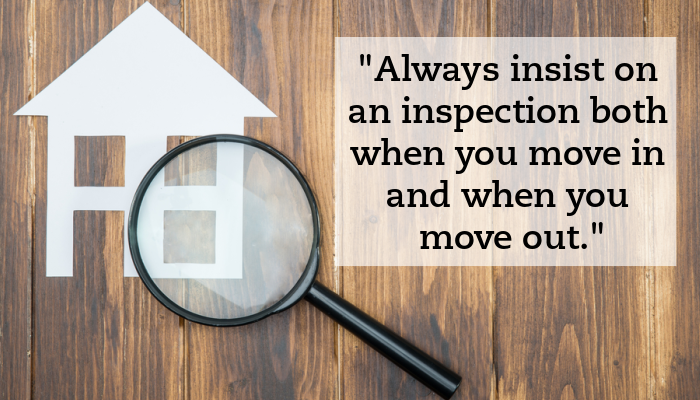You’ve signed the lease and received the keys to your next home. You’re about to move in!
But wait.
One step remains: the completion of the move-in checklist. A move-in checklist helps to document the rental unit’s condition when a tenant first moves into the apartment. Put your excitement on pause long enough to fill it in, and do so with care. A little effort now will pay dividends later—both during your time living in the apartment and when you move out.
How a Move-in Checklist Works
A new tenant rightfully expects to find that their new living space is clean and in good repair. The purpose of a move-in checklist is to ensure both the tenant and landlord alike agree that the apartment is in good condition—or, if the apartment isn’t in good condition, that the landlord will make the necessary repairs as soon as possible.
It also serves as a form of insurance for the tenant. By documenting existing wear and tear in the apartment before you move-in, you protect yourself from being liable for any damage that was caused by a previous tenant when you eventually move out.
Ultimately, openness and transparency benefit tenants and landlords alike. The tenant wants to enjoy a clean, safe and functional living space, and the landlord wants satisfied tenants who have few concerns. When things go well, property owners profit from less turnover and more lease renewals. A move-in checklist and inspection will also help to clarify what the lease makes you accountable for, and what the landlord is responsible for.
Always insist on an inspection both when you move in and when you move out. As you move in, write down anything that needs repairing or replacing. Make a note of any need for cleaning or painting. As you move out, thoroughly document the condition of the unit. Protect yourself against errors or unexpected claims.
How to Make the Most of Your Walkthrough
The proper completion of your move-in checklist requires a thorough walkthrough. Before you move in, examine every nook and cranny of your apartment. In general, landlords are pretty thorough when it comes to preparing an apartment for a new tenant, as both parties have a lot to gain from a smooth move-in. Still, it is possible that the tenant will find something amiss.
Work your way through one room at a time. For a thorough walkthrough, just go to the left. Follow the left wall from room to room until you cover the entire apartment. What’s your general impression? Is everything clean and in good repair? Use your smartphone’s camera to document any damage. First, take a close-up photo. Next, back up to take a wide-angle photo. This makes it easy for the property manager or repair person to locate the spot.
As you go from room to room, pay close attention to the following:
Surfaces
- Walls, floors, ceilings, stairs
- Inside cabinets and closets
- Baseboards and other molding
Are there any holes, cracks, chips, scratches, or dents in the walls, ceiling, or molding? Are carpets and other fabrics stained, torn, frayed, or snagged? Are tiles cracked, loose or missing grout, and are the wood floors scuffed, scraped, scratched, or dented? Is there any sign of flooding or leaking that could cause mold to grow?
Doors and windows
- Doors, including handles, latches and locks
- Windows, including shades/blinds
Do the doors and windows open and close without difficulty? Feel around for drafts around the unit’s windows, and check for broken screens and cracked glass. Do all of the locks on the windows and doors work, without exception?
A new tenant rightfully expects to find that their new living space is clean and in good repair. The purpose of a move-in checklist is to ensure both the tenant and landlord alike agree that the apartment is in good condition—or, if the apartment isn’t in good condition, that the landlord will make the necessary repairs as soon as possible.
Mechanical, Electrical, and Plumbing
Check that the thermostat is accurate. Place your hand over registers to check for heated and cooled air, as appropriate. Properly working air conditioning and heating units aren’t just important for your comfort: it will also help to reduce your utility bill, especially during hot summers or cold winter months.
You’ll also want to check the following:
Water
Take a look at the apartment’s sinks, shower, tub, toilet, and washer/dryer. Does the hot water run hot, and does the cold water run cold? Are there any leaks from the pipes? Does the toilet flush properly? Is the shower/tub clean and in good working order?
Appliances
Check your oven, stove, and dishwasher. Do they work? Are they clean? Are all of the stove’s burners working? Do the doors for the oven and dishwasher open and close properly?
Outlets and Connections
Is the electricity working properly? Do any of the lights or appliances trip the circuit breaker? Are any of the outlets broken?
Lights, Fans, and Smoke Detectors
Do the ceiling fans work when they’re turned on? Are any of the lights flickering or burned out? Is there a functioning smoke detector? Local fire codes require working smoke detectors to keep tenants safe from fire.
Finally, survey any exterior features of your new home as well. This includes outside lighting, a porch or deck, and the condition of any walkways. Are there any trip or falling hazards, such as loose stairs or uneven pavement? Bring any concerns to the attention of your landlord during the inspection.
The Benefits of a Thorough Walkthrough
A careful walkthrough is important for now and in the future. It will:
- Ensure you’ll get the features and ambiance you’re paying for.
- Identify things the landlord might need to repair before or during the tenancy.
- Produce written documentation of the condition of the apartment.
- Avoid later confusion over responsibility for a defect.
- Protect yourself against future claims.
Ultimately, a completed move-in checklist gives you peace-of-mind. It ensures you’ll get the features you’re entitled to. At the same time, it reduces the chance of a landlord-tenant issue at the end of the tenancy. Just remember: a move-in checklist is not complete until it is properly signed. Both the tenant and the landlord (or the landlord’s designated representative) need to add their signatures to the document once the walkthrough is complete.
Find Your Next Apartment with Draper and Kramer
If you’re searching for your next apartment, be sure to check out Draper and Kramer’s portfolio of luxury apartments in your city by visiting draperandkramer.com.

Always insist on an inspection both when you move in and when you move out. As you move in, write down anything that needs repairing or replacing. Make a note of any need for cleaning or painting. As you move out, thoroughly document the condition of the unit. Protect yourself against errors or unexpected claims.